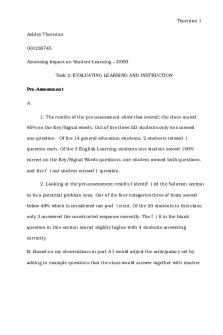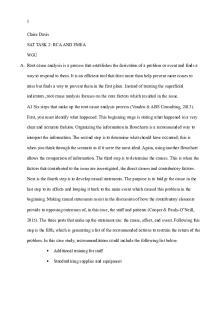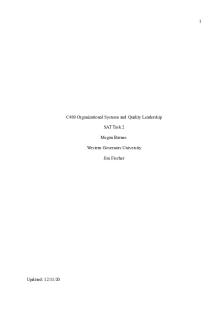DO81 - Task 2 - Task 2 PDF

| Title | DO81 - Task 2 - Task 2 |
|---|---|
| Author | Gracie Ray |
| Course | innovative and strategic thinking |
| Institution | Western Governors University |
| Pages | 5 |
| File Size | 69 KB |
| File Type | |
| Total Downloads | 71 |
| Total Views | 200 |
Summary
Task 2...
Description
Task 2: Innovative and Strategic Thinking Course Code: D081 Student Name: Gracie Ray Student ID: #001275241 Date: 3/5/21 Program Mentor Name: Holly Fletcher
Discuss at least TWO potential risks that the company from the scenario may encounter in entering the new market and describe the impact to the company. (Unit 3: Managing Risks.)
A risk that the company if facing as it enters the Indian market is government compliance. Even though the company is currently in line with their ideals of sustainability and the needs of the consumers for their product- they do not currently have the endorsement of The National Fisheries Development Board. This is a risk as the local fishermen might not trust the company actually has the best interest of the environment without that key endorsement. This will create an impact on the company by forcing them to consider the use of plastics sourced from India. Not only does this possibly impact the design of the company as they need to use recycled plastic as a source instead of only having to ensure their plastic production is recyclable in the end, but it also causes the company to source a factory that allows them to physically produce their product in India.
Another risk to consider could be the collaboration with existing manufacturing companies. Even though I would recommend a Partnership/ Strategic Alliance with a local company to overcome the manufacturing challenge they are facing in order to get the endorsement form the NFDB it presents its own risks. If they create the wrong partnership, they could face issues with differing mission and ethical statements. This creates harm for the company as they would not be holding up their own company values, creating distrust from consumers and investors. They would need to ensure they are doing a due diligence check on not only their possible partners, but their partners’ consumers, supply chain, and processes.
B1. Conduct a SWOT analysis of the company in the scenario by identifying and explaining at least two internal strengths. The identification of each strength requires more than just listing each element. Consider a sentence or two that relates the strength to the given scenario.
Their product design itself can be considered a strength for the company. They are presenting a unique and innovative concept for a boat design. This design is not only useful for the end users, but it perfectly fits into their lifestyles, creating a need for the product. Going beyond the design of the product fitting the desired lifestyle of the consumers, the product’s design is innovative and sustainable. The sustainability market is quickly growing, specifically in India where the government is placing rules and regulations on environmental protections. This ensures the product is desirable on both a consumer and governmental level. Another internal strength is the company culture. This culture champions innovation, collaboration, and creativity. This is beneficial when entering any new market as challenges that could be faces will be met by the entire team. They will be able to work together to come up with solutions that will ensure they receive the best possible outcome. Due to the volume of ideas that can be created with this culture, the company is sure to enter any market with strength and remain at the forefront of the sustainability market.
B2. Conduct a SWOT analysis of the company in the scenario by identifying and explaining at least two internal weaknesses. The identification of each weakness, requires more than just listing each element. Consider a sentence or two that relates the weakness to the given scenario.
A weakness that needs to be considered their decision-making process. While this format for decision making has worked while they were based solely in the U.S., but this might not be the best approach once they set up manufacturing in another country. The input of all employees would slow down the decision-making process once they are spread through different officesnot only due to the volume of employees but the time zones they would be working though. Not only does that delay affect their decisions, but it can affect company momentum and create missed opportunities. Another weakness that could become an issue is the decentralized structure of the company. When they create their manufacturing division in India, they could run into issue of the founders being available to those employees. This could leave those employees disgruntled and unsatisfied with the difference between them and their U.S. counterparts. The other aspect you can look at is this structure is that it can create a lack of authority since the founders are held on the same level of the employees. This could be an issue when it comes to manufacturing and employee discipline on meeting timelines and projected project completion dates.
B3. Conduct a SWOT analysis of the company in the scenario by identifying and explaining at least two external opportunities. The identification of each opportunity requires more than just listing each element. Consider a sentence or two that relates the opportunity to the given scenario.
The market itself is an opportunity for the company. As time progresses, we are seeing a demand for products that are environmentally friendly. Here that is magnified by India, their target market, having laws and regulations about motorized fishing boats and environmental protections. They have an opportunity to fill that market need through their unique and sustainable design of their boat. The other opportunity is to get hands on feedback of the end users. By hiring fishermen to give their feedback on the practicability of the product they are gaining valuable external insight that will assist in creating the best design of the product. This will also allow for the company to create less prototypes and be able to narrow down what is necessary in every design they create.
B4. Conduct a SWOT analysis of the company in the scenario by identifying and explaining at least two external threats. The identification of each threat requires more than just listing each element. Consider a sentence or two that relates the threat to the given scenario.
A threat that is presented is that they have not yet established themselves in the market. Even though they have a product that is desired in the market, there are still other factors that might hinder their entry. They need to form a strategic alliance with another company in order to produce and manufacture in India unless they want to use a greenfield venture. This could pose a problem if no company find value in assisting this company break into the market- since the fishing market is such a niche market and if it is unsuccessful or prolonged, and depletes their financial, their market entry would be unsuccessful. Competition, both local and global, is another threat to the company. Even though this is a newer market in the industry, due to the profitable and growing nature there is bound to be extensive competition. That paired with the fact that they do not have the endorsement of the NFBD at the moment, could prove to be too much for the young company to handle. If another company comes and complies with the requirements for the NFBD endorsement before they are able to move their production to India, the company stands to lose a considerable about of money if they choose a greenfield venture or be unable to hold up their end of a strategic partnership.
Based on the SWOT analysis from B1 – B4, identify and explain TWO strategic recommendations for the company. (Unit 4: Business Strategy.) PLEASE NOTE: The identification of each of the TWO strategic recommendations requires more than just listing each strategy. Consider a sentence or two that relates the recommendations to the SWOT analysis for the given company.
I would suggest that the company look into how to quickly fall under the guidelines that the National Fisheries Development Board require for their endorsement. This will be a key item in the successful launch into the Indian market. To do this they will need to carefully source plastics that originate in India and form relationships with the companies that are in possession of them. This will ensure that the company has access to enough plastics from India for their productions of their boats. This will ensure the company is in compliance with the requirements for the NFDB and they will receive the endorsement that will make them attractive to buyers. My second recommendation would be to alter their decision-making process. Currently they are decentralized, and I would recommend they move to a more centralized decision-making process. There need to be a set group of people that can make a decision as opposed to the entire company needing to collaborate to come to a resolution.
C1. JUSTIFY one strategic recommendation from part C by explaining, in detail, the benefits to that recommendation. Again, this recommendation needs to connect back to the SWOT analysis.
Upon moving to a centralized decision-making process, the company will save themselves a lot of hassle in the future. During their entry into the Indian market, a decentralized structure would see delays appear throughout production and decisions as they involve all employees in that process. By transforming the process to being centralized, the decision-making process would ensure the company has decisions made unilaterally and quickly. This will be vital as they enter into another market across the globe....
Similar Free PDFs

DO81 - Task 2 - Task 2
- 5 Pages

Task 2 - Task 2
- 5 Pages

QHT1 Task 2 - Task 2
- 1 Pages

Task 2 - C226 Task 2
- 7 Pages

D082 Task 2 - Task 2
- 3 Pages

TDT1 Task 2 - Task 2
- 4 Pages

TET1 Task 2 - Task 2
- 4 Pages

C228 Task 2 - Task 2
- 6 Pages

D081 - Task 2 - Task 2
- 2 Pages

D093 Task 2 - task
- 6 Pages

Final CPC TASK 2 - task 2
- 44 Pages

Task 2
- 8 Pages

Task 2
- 10 Pages

C489 Task Two - Task 2
- 7 Pages

CH-C207 Task 2 - task 2
- 7 Pages

C840 Task 2 v1 - Task 2
- 20 Pages
Popular Institutions
- Tinajero National High School - Annex
- Politeknik Caltex Riau
- Yokohama City University
- SGT University
- University of Al-Qadisiyah
- Divine Word College of Vigan
- Techniek College Rotterdam
- Universidade de Santiago
- Universiti Teknologi MARA Cawangan Johor Kampus Pasir Gudang
- Poltekkes Kemenkes Yogyakarta
- Baguio City National High School
- Colegio san marcos
- preparatoria uno
- Centro de Bachillerato Tecnológico Industrial y de Servicios No. 107
- Dalian Maritime University
- Quang Trung Secondary School
- Colegio Tecnológico en Informática
- Corporación Regional de Educación Superior
- Grupo CEDVA
- Dar Al Uloom University
- Centro de Estudios Preuniversitarios de la Universidad Nacional de Ingeniería
- 上智大学
- Aakash International School, Nuna Majara
- San Felipe Neri Catholic School
- Kang Chiao International School - New Taipei City
- Misamis Occidental National High School
- Institución Educativa Escuela Normal Juan Ladrilleros
- Kolehiyo ng Pantukan
- Batanes State College
- Instituto Continental
- Sekolah Menengah Kejuruan Kesehatan Kaltara (Tarakan)
- Colegio de La Inmaculada Concepcion - Cebu